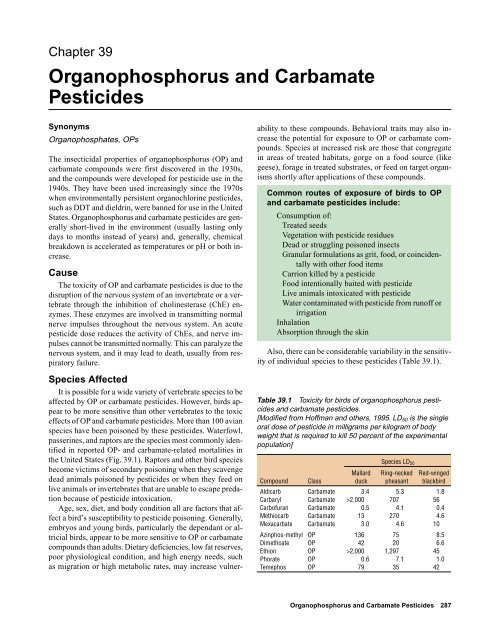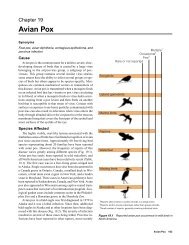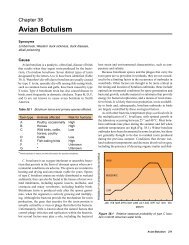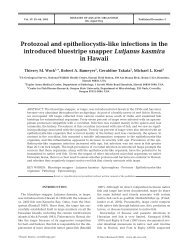Organophosphorus and carbamate pesticides - National Wildlife ...
Organophosphorus and carbamate pesticides - National Wildlife ...
Organophosphorus and carbamate pesticides - National Wildlife ...
You also want an ePaper? Increase the reach of your titles
YUMPU automatically turns print PDFs into web optimized ePapers that Google loves.
Chapter 39<br />
<strong>Organophosphorus</strong> <strong>and</strong> Carbamate<br />
Pesticides<br />
Synonyms<br />
Organophosphates, OPs<br />
The insecticidal properties of organophosphorus (OP) <strong>and</strong><br />
<strong>carbamate</strong> compounds were first discovered in the 1930s,<br />
<strong>and</strong> the compounds were developed for pesticide use in the<br />
1940s. They have been used increasingly since the 1970s<br />
when environmentally persistent organochlorine <strong>pesticides</strong>,<br />
such as DDT <strong>and</strong> dieldrin, were banned for use in the United<br />
States. <strong>Organophosphorus</strong> <strong>and</strong> <strong>carbamate</strong> <strong>pesticides</strong> are generally<br />
short-lived in the environment (usually lasting only<br />
days to months instead of years) <strong>and</strong>, generally, chemical<br />
breakdown is accelerated as temperatures or pH or both increase.<br />
Cause<br />
The toxicity of OP <strong>and</strong> <strong>carbamate</strong> <strong>pesticides</strong> is due to the<br />
disruption of the nervous system of an invertebrate or a vertebrate<br />
through the inhibition of cholinesterase (ChE) enzymes.<br />
These enzymes are involved in transmitting normal<br />
nerve impulses throughout the nervous system. An acute<br />
pesticide dose reduces the activity of ChEs, <strong>and</strong> nerve impulses<br />
cannot be transmitted normally. This can paralyze the<br />
nervous system, <strong>and</strong> it may lead to death, usually from respiratory<br />
failure.<br />
Species Affected<br />
It is possible for a wide variety of vertebrate species to be<br />
affected by OP or <strong>carbamate</strong> <strong>pesticides</strong>. However, birds appear<br />
to be more sensitive than other vertebrates to the toxic<br />
effects of OP <strong>and</strong> <strong>carbamate</strong> <strong>pesticides</strong>. More than 100 avian<br />
species have been poisoned by these <strong>pesticides</strong>. Waterfowl,<br />
passerines, <strong>and</strong> raptors are the species most commonly identified<br />
in reported OP- <strong>and</strong> <strong>carbamate</strong>-related mortalities in<br />
the United States (Fig. 39.1). Raptors <strong>and</strong> other bird species<br />
become victims of secondary poisoning when they scavenge<br />
dead animals poisoned by <strong>pesticides</strong> or when they feed on<br />
live animals or invertebrates that are unable to escape predation<br />
because of pesticide intoxication.<br />
Age, sex, diet, <strong>and</strong> body condition all are factors that affect<br />
a bird’s susceptibility to pesticide poisoning. Generally,<br />
embryos <strong>and</strong> young birds, particularly the dependant or altricial<br />
birds, appear to be more sensitive to OP or <strong>carbamate</strong><br />
compounds than adults. Dietary deficiencies, low fat reserves,<br />
poor physiological condition, <strong>and</strong> high energy needs, such<br />
as migration or high metabolic rates, may increase vulnerability<br />
to these compounds. Behavioral traits may also increase<br />
the potential for exposure to OP or <strong>carbamate</strong> compounds.<br />
Species at increased risk are those that congregate<br />
in areas of treated habitats, gorge on a food source (like<br />
geese), forage in treated substrates, or feed on target organisms<br />
shortly after applications of these compounds.<br />
Common routes of exposure of birds to OP<br />
<strong>and</strong> <strong>carbamate</strong> <strong>pesticides</strong> include:<br />
Consumption of:<br />
Treated seeds<br />
Vegetation with pesticide residues<br />
Dead or struggling poisoned insects<br />
Granular formulations as grit, food, or coincidentally<br />
with other food items<br />
Carrion killed by a pesticide<br />
Food intentionally baited with pesticide<br />
Live animals intoxicated with pesticide<br />
Water contaminated with pesticide from runoff or<br />
irrigation<br />
Inhalation<br />
Absorption through the skin<br />
Also, there can be considerable variability in the sensitivity<br />
of individual species to these <strong>pesticides</strong> (Table 39.1).<br />
Table 39.1 Toxicity for birds of organophosphorus <strong>pesticides</strong><br />
<strong>and</strong> <strong>carbamate</strong> <strong>pesticides</strong>.<br />
[Modified from Hoffman <strong>and</strong> others, 1995. LD 50 is the single<br />
oral dose of pesticide in milligrams per kilogram of body<br />
weight that is required to kill 50 percent of the experimental<br />
population]<br />
Species LD 50<br />
Mallard Ring-necked Red-winged<br />
Compound Class duck pheasant blackbird<br />
Aldicarb Carbamate 3.4 5.3 1.8<br />
Carbaryl Carbamate >2,000 707 56<br />
Carbofuran Carbamate 0.5 4.1 0.4<br />
Methiocarb Carbamate 13 270 4.6<br />
Mexacarbate Carbamate 3.0 4.6 10<br />
Azinphos-methyl OP 136 75 8.5<br />
Dimethoate OP 42 20 6.6<br />
Ethion OP >2,000 1,297 45<br />
Phorate OP 0.6 7.1 1.0<br />
Temephos OP 79 35 42<br />
<strong>Organophosphorus</strong> <strong>and</strong> Carbamate Pesticides 287
Common (greater than 45 percent of die-offs)<br />
Frequent (11–44 percent of die-offs)<br />
Occasional (4–10 percent of die-offs)<br />
Infrequent (less than 3 percent of die-offs)<br />
Passerines<br />
Waterfowl<br />
Raptors<br />
Waterbirds<br />
Jays <strong>and</strong> crows<br />
Blackbirds<br />
Seed-eating birds<br />
Thrushes <strong>and</strong> bluebirds<br />
Swallows<br />
Other<br />
Geese<br />
Surface-feeding ducks<br />
Diving ducks<br />
Other waterfowl<br />
Eagles<br />
Hawks<br />
Owls<br />
Vultures<br />
Falcons<br />
Shorebirds<br />
Wading birds<br />
Gulls<br />
Coot<br />
Upl<strong>and</strong> gamebirds<br />
Doves<br />
Other<br />
Figure 39.1 Frequency of occurrence of major groups of birds in documented organophosphorus<br />
<strong>and</strong> <strong>carbamate</strong> pesticide mortality events from 1986–95 (<strong>National</strong> <strong>Wildlife</strong> Health Center data<br />
base).<br />
288 Field Manual of <strong>Wildlife</strong> Diseases: Birds
Distribution<br />
<strong>Organophosphorus</strong> <strong>and</strong> <strong>carbamate</strong> compounds are used<br />
throughout the world as insecticides, herbicides, nematocides,<br />
acaricides, fungicides, rodenticides, avicides, <strong>and</strong> bird<br />
repellants. These compounds are applied in a wide variety<br />
of habitats including agricultural l<strong>and</strong>s, forests, rangel<strong>and</strong>s,<br />
wetl<strong>and</strong>s, residential areas, <strong>and</strong> commercial sites. Wild bird<br />
deaths from OP <strong>and</strong> <strong>carbamate</strong> poisoning have been reported<br />
throughout the United States (Fig. 39.2). In more than half<br />
of these mortality incidents, the pesticide source is unknown<br />
(Fig. 39.3). Known applications of these compounds fall into<br />
five groups: approved applications in 1) agricultural l<strong>and</strong> uses<br />
such as field <strong>and</strong> row crops, pastures, orchards, <strong>and</strong> forests;<br />
2) residential <strong>and</strong> urban sites for turf in parks, golf courses,<br />
yards, <strong>and</strong> other urban pest control uses; 3) livestock uses<br />
such as pour-ons or feed products; 4) vertebrate pest control;<br />
<strong>and</strong> 5) malicious pesticide use, such as baiting to intentionally<br />
harm wildlife (Fig. 39.3).<br />
EXPLANATION<br />
Mortality events—Each circle represents<br />
the total number of events for a State. Circle<br />
size is proportional to number of events<br />
20<br />
15<br />
10<br />
5<br />
1<br />
Pesticide<br />
Carbofuran<br />
Diazinon<br />
Famphur<br />
Phorate<br />
Parathion<br />
Monocrotophos<br />
Fenthion<br />
Chlorpyrifos<br />
Other<br />
Figure 39.2 Distribution of 181 avian mortality events caused by organophosphorus <strong>and</strong> <strong>carbamate</strong> <strong>pesticides</strong>, 1986–1995<br />
(<strong>National</strong> <strong>Wildlife</strong> Health Center data base).<br />
<strong>Organophosphorus</strong> <strong>and</strong> Carbamate Pesticides 289
Residential<br />
8.4 percent<br />
Golf course<br />
1.1 percent<br />
Agricultural<br />
20 percent<br />
Misuse<br />
15.1<br />
Unknown<br />
53.6 percent<br />
Pest control<br />
1.7 percent<br />
Figure 39.3 Applications associated with avian mortality<br />
caused by organophosphorus <strong>and</strong> <strong>carbamate</strong> <strong>pesticides</strong> from<br />
1986–95 (<strong>National</strong> <strong>Wildlife</strong> Health Center data base).<br />
Seasonality<br />
Because OP <strong>and</strong> <strong>carbamate</strong> <strong>pesticides</strong> are typically shortlived<br />
in the environment, seasonality of avian mortality is<br />
generally associated with pesticide applications (Fig. 39.4).<br />
In documented mortality events in the United States, February<br />
was the peak month for the onset of bird die-offs, <strong>and</strong><br />
most of these die-offs occurred in the southern United States,<br />
where the growing season starts early in the year.<br />
Clinical signs <strong>and</strong> bird behaviors that are commonly<br />
associated with acute exposure to<br />
cholinesterase-inhibiting <strong>pesticides</strong><br />
[Modified from Mineau, 1991]<br />
Convulsions<br />
Hyperexcitability<br />
Incoordination of muscular action (ataxia)<br />
Muscular weakness (myasthenia)<br />
Difficult breathing (dyspnea)<br />
Rapid breathing (tachypnea)<br />
Vomiting<br />
Defecation<br />
Diarrhea<br />
Spasmodic contraction of anal sphincter (tenesmus)<br />
Lethargy<br />
Induced tranquility<br />
Head <strong>and</strong> limbs arched back (opisthotonos)<br />
Slight paralysis (paresis)<br />
Blindness<br />
Contraction of pupils (miosis)<br />
Dilation of pupils (mydriasis)<br />
Drooping of eyelid (ptosis)<br />
Protrusion of eyes (exopthalmia)<br />
Excessive tear formation (lacrimation)<br />
Excessive thirst (polydypsia)<br />
Bleeding from nares (epistaxis)<br />
Erection of contour feathers (piloerection)<br />
35<br />
NUMBER OF EVENTS<br />
30<br />
25<br />
20<br />
15<br />
10<br />
5<br />
0<br />
JAN FEB MAR APRIL MAY JUNE JULY AUG SEPT OCT NOV DEC<br />
MONTH<br />
Figure 39.4 Avian mortality events due to organophosphorus<br />
<strong>and</strong> <strong>carbamate</strong> <strong>pesticides</strong> by date of onset, 1986–95<br />
(<strong>National</strong> <strong>Wildlife</strong> Health Center data base).<br />
Field Signs<br />
Mortality can be the first sign noted in a pesticide poisoning,<br />
but the observer may find other clues at the scene of<br />
a mortality event. Live affected birds may exhibit convulsions,<br />
lethargy, paralysis, tremors, or other nonspecific neurological<br />
signs.<br />
Birds that die rapidly with pronounced neurological signs<br />
may leave evidence of their struggle even after death, such<br />
as vegetation clenched in their talons (Fig. 39.5) or vegetation<br />
that they disturbed during thrashing or convulsions. Animals<br />
may not have time to disperse before the toxin takes<br />
effect, <strong>and</strong> carcasses of multiple species, especially predators<br />
<strong>and</strong> granivorous or insectivorous wildlife, may be found<br />
within the same area following OP or <strong>carbamate</strong> exposure.<br />
Birds can also be affected by a sublethal dose of an OP or<br />
<strong>carbamate</strong> pesticide. Sublethal exposure may contribute to<br />
other causes of mortality in birds, such as trauma. In some<br />
instances when birds have died due to trauma from a vehicle<br />
impact, a building strike, or predation, decreased brain ChE<br />
has been demonstrated, which indicates pesticide exposure.<br />
The sublethal dose of pesticide likely impaired the nervous<br />
system enough to alter behavior, thus making the animal more<br />
vulnerable to a traumatic cause of death. Special studies that<br />
evaluated sublethal OP or <strong>carbamate</strong> compound exposure in<br />
birds have found other effects to birds, including a reduced<br />
ability to regulate body temperature; impaired reproduction;<br />
<strong>and</strong> reduced tolerance to cold stress, which can cause reduced<br />
activity, leading to decreased feeding <strong>and</strong> weight loss.<br />
Altered behaviors such as reduced nest attentiveness <strong>and</strong><br />
changes in singing by passerines have also been observed.<br />
290 Field Manual of <strong>Wildlife</strong> Diseases: Birds
Figure 39.5 Vegetation clenched in the talons of a bald eagle,<br />
which is a finding consistent with organophosphorus or <strong>carbamate</strong><br />
poisoning in raptors.<br />
Gross Findings<br />
Granular material or the presence of dye or both in the<br />
gastrointestinal tract are conspicuous findings that implicate<br />
pesticide ingestion. The necropsy finding of freshly ingested<br />
food in the upper gastrointestinal tract of a carcass is a good<br />
indicator of death by intoxication, especially when a large<br />
amount of a uniform food item is present. Feathers, flesh,<br />
hair, or other animal parts in the stomachs of raptors or of<br />
scavengers are common in secondary poisoning, whereas<br />
ingested grain is often found in waterfowl <strong>and</strong> passerines<br />
(Fig. 39.6). The food item may indicate the pesticide source,<br />
<strong>and</strong> the food can then be analyzed for specific chemical compounds.<br />
The gross lesions that are associated with acute mortality<br />
from pesticide poisoning in birds are nonspecific <strong>and</strong> are<br />
usually minimal. Reddening of the intestinal wall, or even<br />
hemorrhage (Fig. 39.7), is observed occasionally with ingestion<br />
of certain <strong>pesticides</strong>. Redness <strong>and</strong> excess fluid in the<br />
lungs may be observed; these findings are consistent with<br />
respiratory failure. However, these changes are not unique<br />
to pesticide poisonings; they can be found in animals that<br />
died from other causes.<br />
Diagnosis<br />
A diagnostic evaluation is essential. A diagnosis of pesticide<br />
poisoning in birds is based on evidence of ChE inhibition<br />
in the brain or the blood <strong>and</strong> identification of pesticide<br />
residues in gastrointestinal contents. In many instances, depressed<br />
ChE activity will be the first indication that OP or<br />
<strong>carbamate</strong> <strong>pesticides</strong> caused a mortality event. A necropsy is<br />
necessary to rule out other causes of mortality or to identify<br />
contributing causes.<br />
Brain ChE activity is a reliable indicator of OP <strong>and</strong> <strong>carbamate</strong><br />
exposure in dead birds, but the absence of ChE depression<br />
does not reliably rule out poisoning. Brain ChE<br />
activity is measured <strong>and</strong> compared to normal brain ChE<br />
Photo by James Runningen<br />
activity of the same species to determine the decrease in enzyme<br />
activity from normal levels (Appendix D). A decrease<br />
in brain ChE activity of 25 percent or more from normal<br />
indicates exposure to a cholinesterase-inhibiting compound<br />
(OP or <strong>carbamate</strong> pesticide); a decrease of 50 percent or more<br />
from normal is evidence of lethal exposure. Because of the<br />
variation in results between laboratories <strong>and</strong> the variability<br />
even between methods <strong>and</strong> procedures within a lab, it is important<br />
to compare results with controls from the same laboratory<br />
using the same method <strong>and</strong> not interpret analytical<br />
results from two or more laboratories or from two or more<br />
analytical methods.<br />
Analyses can be carried one step further to differentiate<br />
the effect of OP from <strong>carbamate</strong> compounds by measuring<br />
the enzyme activity of a sample after incubation at 37–<br />
40 °C <strong>and</strong> comparing it to the initial measurement. Enzyme<br />
activity that returns toward a normal level after incubation,<br />
or that reactivates, indicates that <strong>carbamate</strong> poisoning is likely<br />
because <strong>carbamate</strong>s tend to release their bond with ChE over<br />
time at increased temperatures or in aqueous environments.<br />
Because reactivation can occur with some <strong>pesticides</strong>, depressed<br />
brain ChE activity in a pesticide-poisoned bird may<br />
be difficult to document if the carcass has remained in a warm<br />
environment for an extended period of time. Another method<br />
that is used to differentiate an OP from a <strong>carbamate</strong> compound<br />
exposure is reactivation analysis, during which 2-<br />
PAM, a cholinesterase regenerating agent, is added to the<br />
sample <strong>and</strong> the change in brain ChE activity is then measured.<br />
Reactivation of ChE activity using 2-PAM occurs only<br />
when an OP compound is bound to the enzyme.<br />
When a pesticide die-off is suspected, it is important to<br />
chill carcasses immediately. If diagnostic evaluation cannot<br />
be initiated within 24–48 hours, carcasses should be frozen<br />
as soon as possible to prevent further change in brain ChE<br />
activity. Also, when normal brain ChE activity values are<br />
not known for a particular species, control samples collected<br />
from normal birds of the same species are needed in order to<br />
compare ChE values.<br />
In birds that recover from OP or <strong>carbamate</strong> poisoning,<br />
brain ChE activity will typically increase but it may remain<br />
below normal levels for up to 3 weeks, depending on the<br />
compound <strong>and</strong> on the dose received. Cholinesterase activity<br />
in blood from live birds may be used as an indicator of pesticide<br />
exposure; however, blood ChE activity is more variable<br />
than brain ChE activity. Cholinesterase enzymes in the<br />
blood are more sensitive than brain ChE to OP <strong>and</strong> <strong>carbamate</strong><br />
<strong>pesticides</strong>; therefore, pesticide exposure quickly <strong>and</strong> dramatically<br />
depresses blood ChE activity, which then rapidly<br />
returns to normal levels.<br />
One advantage of measuring blood ChE activity is that a<br />
nonlethal sample can be taken to provide evidence of OP or<br />
<strong>carbamate</strong> pesticide exposure in live birds. A disadvantage<br />
of measuring blood ChE activity is that interpretation is difficult<br />
because normal blood ChE activity varies among spe-<br />
<strong>Organophosphorus</strong> <strong>and</strong> Carbamate Pesticides 291
A<br />
Photo by J. Christian Franson<br />
B<br />
Photo by J. Christian Franson<br />
C<br />
Photo by J. Christian Franson<br />
D<br />
Photo by James Runningen<br />
Figure 39.6 Examples of food items found in the gastrointestinal tracts of birds that died from organophosphorus or <strong>carbamate</strong><br />
poisoning. (A) Pig remains from the crop of a bald eagle. (B) Bovine skin from the stomach of a bald eagle. (C) Bovine hair<br />
from the stomach of a magpie. (D) Corn in the esophagus of a mallard.<br />
cies, age, sex, <strong>and</strong> body condition, <strong>and</strong> because a diurnal<br />
ChE variation may occur in some species. The reactivation<br />
analysis described above, which is used to differentiate an<br />
OP- from a <strong>carbamate</strong>-induced intoxication when measuring<br />
brain ChE activity, can also be used to evaluate blood<br />
ChE activity. In live animals, a presumptive diagnosis can<br />
also be made by reversing the neurological signs with proper<br />
medical treatment.<br />
Specific compound residues may be identified in gastrointestinal<br />
contents. Mass spectrometry <strong>and</strong> gas chromatography<br />
are the usual analytical methods. Table 39.3 lists<br />
the compounds that were identified as the cause of mortality<br />
in the documented wild bird mortality events illustrated in<br />
Fig. 39.2.<br />
Table 39.3 Specific organophosphorus <strong>and</strong> <strong>carbamate</strong><br />
<strong>pesticides</strong> known to cause wild bird mortality events.<br />
Carbamates<br />
<strong>Organophosphorus</strong> compounds<br />
Carbofuran Chlorpyrifos Fenthion<br />
Methiocarb Diazinon Fonofos<br />
Oxamyl Dicrotophos Methamidophos<br />
Aldicarb Dimethoate Monocrotophos<br />
Disulfoton Parathion<br />
Famphur 1 Phorate<br />
Fenamiphos Phosphamidon<br />
Fensulfothion Terbufos<br />
1 Famphur is regulated by the Food <strong>and</strong> Drug Administration as a drug.<br />
Control<br />
When a die-off with a confirmed pesticide poisoning diagnosis<br />
has occurred, birds should be denied use of the pesticide-affected<br />
area. Carcass pickup is necessary to prevent<br />
secondary toxicity to scavengers <strong>and</strong> prevent mortality from<br />
other causes related to decomposing carcasses, such as botulism.<br />
Any remaining pesticide in bags, on treated seed, bait,<br />
or grain must be removed to prevent further mortality.<br />
292 Field Manual of <strong>Wildlife</strong> Diseases: Birds
Figure 39.7 Hemorrhage in the intestine is an occasional<br />
finding in waterfowl that died of exposure to <strong>pesticides</strong>, particularly<br />
organophosphorus compounds.<br />
Followup to wildlife mortality incidents due to pesticide<br />
poisoning is important for determining the source <strong>and</strong> the<br />
use of a chemical. Documented wildlife mortality from approved<br />
pesticide applications is considered by regulatory<br />
authorities for developing label use restrictions <strong>and</strong> for<br />
licensing pesticide formulations. Malicious use of <strong>pesticides</strong><br />
to kill unwanted wildlife is against the law, <strong>and</strong> legal means<br />
can be employed to stop illegal use.<br />
Persons who apply <strong>pesticides</strong> need to consider wildlife<br />
use <strong>and</strong> environmental conditions when they apply the chemicals.<br />
Migration patterns of the wildlife that use the area, the<br />
presence of nesting <strong>and</strong> breeding species, <strong>and</strong> weather conditions,<br />
such as the potential for aerial drift or runoff into<br />
wetl<strong>and</strong>s or ponds, are among the factors that should be considered.<br />
Pesticides should be applied only as directed; the<br />
use of alternate chemicals or formulations that pose less risk<br />
to nontarget species should also be considered. Buffer zones<br />
at crop perimeters will provide more protection to areas used<br />
by wildlife. Agricultural l<strong>and</strong> planted adjacent to wetl<strong>and</strong>s<br />
should be plowed parallel to a wetl<strong>and</strong> to minimize runoff.<br />
Human Health Considerations<br />
Human exposure to OP or <strong>carbamate</strong> <strong>pesticides</strong> can result<br />
in serious illness or even death. Exposure can occur<br />
through inhalation, absorption through the skin, or by ingestion.<br />
When <strong>pesticides</strong> that may be associated with wildlife<br />
mortality incidents are investigated, field procedures should<br />
be scrutinized to avoid inadvertent exposure of personnel to<br />
<strong>pesticides</strong>. Persons who collect carcasses or field samples<br />
must prevent their exposure by wearing nonpermeable gloves,<br />
rubber boots, or other appropriate clothing that will prevent<br />
skin absorption, <strong>and</strong> respirators should be used if chemical<br />
inhalation is possible.<br />
Poisoning in humans should be treated as a serious medical<br />
emergency. When someone seeks medical attention for<br />
exposure to an OP or <strong>carbamate</strong> compound, the attending<br />
Photo by Paul Soler<br />
physician should be informed that the person may have been<br />
exposed to these chemicals. Patients can be monitored by<br />
blood sampling to evaluate their blood ChE levels. Aggressive<br />
treatment of acute intoxication does not protect against<br />
the possibility of delayed onset neurotoxicity or persistent<br />
neurological defects. Certain compounds have been documented<br />
to cause delayed effects in humans. An intermediate<br />
syndrome that occurs within 24–96 hours after exposure has<br />
recently been described with intoxications of fenthion,<br />
dimethoate, monocrotophos, <strong>and</strong> methamidophos. Muscles<br />
of the limbs <strong>and</strong> those innervated by cranial nerves are affected,<br />
causing palsies, respiratory depression, <strong>and</strong> distress.<br />
Another delayed neurotoxicity from some OP compounds<br />
can occur 1–2 weeks after exposure. Initially, incoordination<br />
develops, <strong>and</strong> it can progress to moderate to severe<br />
muscle weakness <strong>and</strong> paralysis. This delayed effect was<br />
documented with some OP compounds that were rarely used<br />
as <strong>pesticides</strong>, but the effect may be a potential risk with similar<br />
compounds that are more commonly used today if sufficient<br />
exposure to the compound occurs. These delayed effects<br />
could be a problem in wildlife, but they have not been<br />
recognized yet in any wildlife species.<br />
Linda C. Glaser<br />
Supplementary Reading<br />
Amdur, M.O., Doull, J., <strong>and</strong> Klaassen, D.C., eds., 1991, Casarett<br />
<strong>and</strong> Doull's Toxicology, The basic science of poisons, (4th<br />
ed.): Elmsford, N.Y., Pergamon Press, 1,033 p.<br />
Grue, C.E., Fleming, W.J., Busby, D.G., <strong>and</strong> Hill, E.F., 1983,<br />
Assessing hazards of organophosphate <strong>pesticides</strong> in wildlife,<br />
in Transactions of the 48th North American <strong>Wildlife</strong> &<br />
Natural Resources Conference: Washington, D.C., The<br />
<strong>Wildlife</strong> Management Institute, p 200–220.<br />
Hill, E.F. <strong>and</strong> Fleming, W.J., 1982, Anticholinesterase poisoning<br />
of birds: field monitoring <strong>and</strong> diagnosis of acute poisoning:<br />
Environmental Toxicology <strong>and</strong> Chemistry 1:27–38.<br />
Hill, E.F., 1995, <strong>Organophosphorus</strong> <strong>and</strong> <strong>carbamate</strong> <strong>pesticides</strong>, in<br />
Hoffman, D.H., Rattner, B.A., Burton, G.A., Jr., <strong>and</strong> Cairns,<br />
J., Jr., eds., H<strong>and</strong>book of ecotoxicology: Boca Raton, Fla.,<br />
Lewis Publishers, p 243–274.<br />
Mineau, P., ed., 1991, Cholinesterase-inhibiting Insecticides,<br />
Their impact on wildlife <strong>and</strong> the environment, chemicals in<br />
agriculture v. 2.: Amsterdam, The Netherl<strong>and</strong>s, Elsevier<br />
Science Publishing, 348 p.<br />
Smith, G.J., 1987, Pesticide use <strong>and</strong> toxicology in relation to<br />
wildlife: <strong>Organophosphorus</strong> <strong>and</strong> <strong>carbamate</strong> compounds:<br />
Washington, D.C., U.S. Department of the Interior, Fish <strong>and</strong><br />
<strong>Wildlife</strong> Service, Resource Publication 170, 171 p.<br />
<strong>Organophosphorus</strong> <strong>and</strong> Carbamate Pesticides 293
294 Field Manual of <strong>Wildlife</strong> Diseases: Birds
















